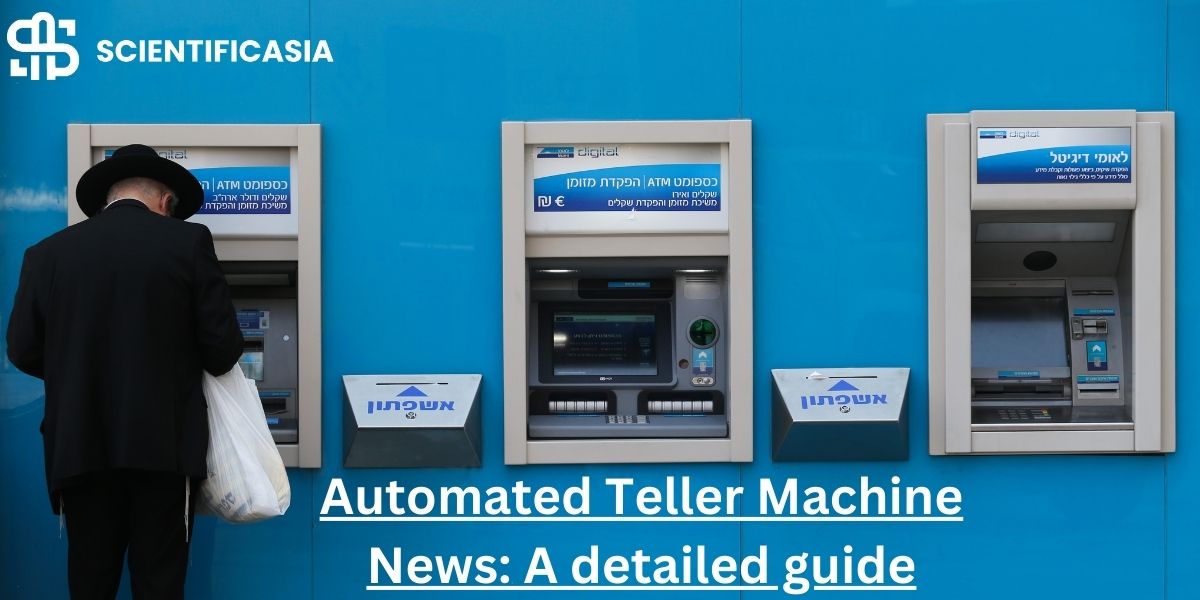Increasing ATM theft, as well as the security of ATMs, is a big problem. Criminals are using every force to rob the net cash, so be careful when using ATMs. The invention of bitcoin, which enables users to take net cash and purchase cryptocurrency, is the advance sign of invention. So, the investment in the cryptocurrency is the inheritance risk that is connected with the new battle.
Development of ATM
With time the automated teller machine has made many changes, which completely changed the people’s banking system. After this introduction, ATMs became an important part of the international financial ecosystem which provides countless facilities to customers.
Market Analysis and Predict
Market outlook forecasts, which project trends from 2024 to 2031, offer insightful analyses of ATM trends for the future. Key players, including financial institutions and technology suppliers, can benefit from strategic advice on managing the changing ATM landscape by having a thorough understanding of market projections.
Regional Views and Their Effects
Examining ATMs from a regional perspective reveals the distinct opportunities and problems that distinct regions face. Every location, from Asia to Europe and beyond, has a different approach to automated banking, which is influenced by legislative frameworks and cultural quirks that affect how the ATM business develops.
Cash: Not at the end of the world
Cash withdrawals continue to demonstrate surprisingly strong resistance, despite widespread predictions of a paperless society dominated by contactless payments and mobile wallets. According to a recent study by The Independent [Independent news on ATM], ATM withdrawals in the UK have increased for the second year in a row.
There are similar trends observed in other regions of the world, especially among elderly populations or individuals who place high importance on transactional privacy and anonymity. The same data shows that the busiest day for ATM withdrawals in 2023 would be the Friday before Christmas, highlighting the continued importance of cash in holiday shopping binges. These figures imply that cash is still a reliable and practical method of managing finances for a sizable segment of the populace.
Once a pillar of every high street, the reliable ATM is having an identity problem. There’s a discernible shift towards a more digital future even while cash withdrawals are still increasing in many countries, such as the UK. Here’s a look at some recent developments in the ATM industry:
Crypto ATMs are a development in the market
ATMs in the one zone where cryptocurrency is becoming more popular in this world and made itself. Customers may purchase and business cryptocurrencies with cash at crypto ATMs, such as Bitcoin and many more. Through the Cointelegraph [Cointelegraph news on ATM], the emerging welcome of cryptocurrencies has guided a recent pin in the attraction of these devices. But as of late 2022, the tendency appears to have peaked.
Though the causes are yet unknown, possible answers include changes in the market, heightened governmental attention to cryptocurrencies, or just market saturation in the specialized sector. Anyway, developments such as the combination of the Lightning Network—a fast and cheap method of finished cryptocurrency business—are being investigated to improve authentication. This Increases again interest in cryptocurrency ATMs finds the best way to sell and purchase the cryptocurrency and increases the ability of appeal.
Security issues are the continuous danger
ATM security breaches continue to be a big worry. A recent spate of ATM thefts in India was covered by NDTV [NDTV news on ATM], when thieves utilized explosives and gas cutters as well as other brute force techniques to take out cash. This emphasizes the requirement for strong security measures, such as enhanced surveillance, more resistant machine casings, and better encryption. Prioritizing security updates is imperative for banks and ATM operators to safeguard user data and discourage would-be hackers.
The “Cash Hub” Model’s Climb
The decrease in ATM usage and bank branch closures raise questions about cash availability, especially for people living in underprivileged areas. The “Cash Hub” concept presents a possible fix.
Supported by groups such as the Banking Hub Company in the UK, these hubs combine several financial services, such as ATMs, into one central location. By giving people in places with few traditional banking facilities access to basic banking services, this strategy guarantees financial inclusion for everybody.
Beyond Cash: A valuable aspect
With the growing popularity of digital payments, ATMs will probably serve more purposes than just disbursing cash. It is anticipated that these financial service kiosks will expand in functionality and become more adaptable.
The following are some possible changes:
Bill Payment Powerhouse: Just picture using an ATM to pay your rent, phone bills, or even energy bills. Users would save time and effort by not having to send cheques or connect to numerous internet portals as a result.
Convenience of Mobile Top-Up: Are you short on credit on your phone? ATMs may eventually serve as one-stop stores where you can top off your mobile phone balance to keep connected while you’re on the go.
Check Deposit Efficiency: If ATMs had integrated check scanners, depositing checks may be a breeze. This would provide more flexibility and convenience by doing away with the requirement to visit a bank branch during regular business hours.
Biometric Authentication for Security: ATMs may soon come equipped with fingerprint scanners, iris or facial recognition software, or both. Providing a more reliable method of user identity verification and lowering the possibility of fraudulent behavior, will improve security.
ATMs could easily interface with mobile banking applications through mobile banking integration. Consider ordering cash for pick-up at the ATM straight from your app, receiving withdrawal notifications on your phone, and remotely adjusting withdrawal limits. An easier-to-use and more integrated banking experience would result from this.
Specialization and market opportunity
ATMs of the future may also need to be specialized.
ATMs might be able to meet certain demands, like:
Crypto ATM: As well the use of crypto ATMs is increasing its availability in limited areas but with time will be common in every area. They provide a simple way to the customers of selling and purchase cryptocurrency which provides an easy access point that is aware of the digital world.
Gold ATMs: Although the first gold ATM in history was created in India, it raises the prospect that future ATMs could be designed to meet certain investment needs. Users may be able to immediately buy actual gold or other precious metals from these ATMs.
Gold-made ATM is not star
India has launched the world’s first gold automated teller machine (ATM) for those looking for a bit of uniqueness! With this clever system, customers can use their debit cards to buy actual gold. Although the long-term feasibility of this specialized idea is still unclear, it undoubtedly embodies the innovative spirit of the ATM sector.
The appearance of Financial Centers: Complete the gap due to branch closures
Concerns regarding cash availability are raised by the trend of bank branch closures and the decrease in ATM usage, especially for people living in underprivileged areas. Initiatives like Banking Hubs are emerging to solve this problem.
In places where access to traditional banking facilities is limited, these hubs—led by groups like the UK’s Banking Hub Company—offer a variety of financial services, including ATM access. With this strategy, everyone is guaranteed financial inclusion, and the void left by branch closures is filled.
Partnership for mutual benefits with digital banking
ATMs will coexist peacefully with digital banking in the future, not take its place. With its convenient and secure access to a broader range of financial services, ATMs are expected to become an extension of digital banking. This would provide customers the option to select the approach that best fits their needs, be it using their phone to manage their accounts or physically using an ATM to complete certain operations.
Future of ATM
ATMs will probably change as our banking practices do. Traditional cash withdrawals may continue to drop while other services like bill payment, phone top-ups, and check deposits grow.
Conclusion: A Shifting ground
There is a big change happening to the ATM scene. Even if cash might not completely disappear shortly, ATMs are undoubtedly changing to accommodate a more varied and digital financial ecology. ATMs will probably keep changing and offer more services in addition to cash disbursements as consumer demands and technological advancements drive this trend. The ATM of the future may combine innovation and tradition to meet the requirements of both digital enthusiasts and cash-wielding traditionalists.
FAQs
Which kinds of automated teller machines are most common?
The following are the most often-used kinds of automated teller machines (ATMs):
Freestanding ATMs: These are the most prevalent kind of retail ATMs and are well-liked by a range of enterprises due to their location versatility.
Web ATMs: Smart card reader-based online interfaces for ATM card banking that provide all standard ATM features except cash withdrawals. Taiwan has a lot of this kind.
Freestanding ATMs, sometimes referred to as stand-alone ATMs, are extensively utilized in retail environments and are offered by leading manufacturers such as Nautilus Hyosung, Genmega, Triton, and Hantle. With a range of features and functionality to meet diverse company demands, they are available in both new and used versions.
What characteristics of automated teller machines are most prevalent?
The following are the most typical attributes of automated teller machines (ATMs):
Cash Withdrawals: Automated teller machines (ATMs) give users the convenience of taking cash out of their bank accounts at any time, eliminating the need to speak with bank employees directly.
Deposits: An easy approach to add funds without going to a real bank branch is to use one of the many ATMs that offer the capability to deposit cash or cheques into a customer’s account.
Fund transfers: By enabling customers to move money between accounts, certain ATMs make it possible to do quick and simple transactions without the need for extra banking services.
Balance Inquiries: Through ATMs, users can get real-time updates on their financial situation by checking their account balances and obtaining account information.
Printing of Receipts: To ensure that customers have a record of the actions they took at the machine, most ATMs send consumers printed receipts outlining their transactions.
Security Features: To guarantee safe transactions and safeguard consumer information, ATMs use a variety of security procedures, including card authentication, one-time passwords (OTPs), and Personal Identification Numbers (PINs).
Audio Instructions: To improve accessibility for all users, some ATMs come with integrated external speakers that play recorded sounds or employ text-to-speech synthesis to provide information to users.
What benefits do automated teller machines offer over physical bank branches?
Automated Teller Machines (ATMs) have the following benefits over traditional bank branches:
Better Customer Service: By cutting down on wait times at traditional banks, ATMs improve customer service.
Cost-effectiveness: Because ATMs eliminate the need for human tellers, financial institutions can operate at a reduced cost.
Accessibility: ATMs give users convenient and flexible banking services by enabling them to access their accounts from many locations around the clock.
Security: ATMs are more secure than carrying cash because, according to reports, stolen ATM cards can be revoked to stop illegal transactions.
Convenience: Using ATMs instead of traditional banking methods is more convenient because of drive-up ATMs and the simplicity of carrying a card instead of cash.
No queues: Compared to actual bank branches, ATMs frequently have fewer or no queues, which saves users time and decreases wait times.
Cash Storage: Rather than being carried about in a person’s pocket, cash taken out of ATMs is safely kept in the bank, reducing the possibility of loss or theft.










